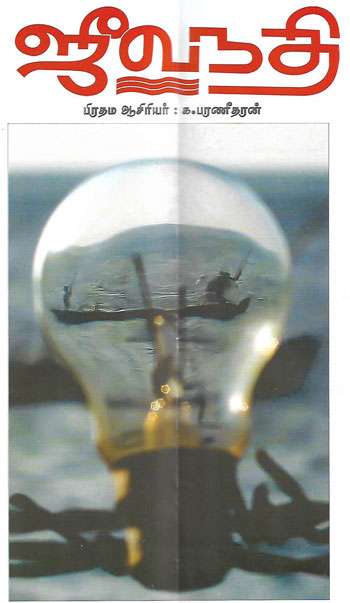Reply To:
Name - Reply Comment
Last Updated : 2024-04-19 11:04:00
 For the past several months young psychology student Kalaamani Bharaneetharan has been publishing a creditably edited and designed monthly literary magazine in Tamil from Alvaai in the Northern Peninsula. The magazine containing well-researched articles cost Rs.100 a copy. Subscribers are requested to contact the editor in chief at Kalai Aham, Alvaai North West.
For the past several months young psychology student Kalaamani Bharaneetharan has been publishing a creditably edited and designed monthly literary magazine in Tamil from Alvaai in the Northern Peninsula. The magazine containing well-researched articles cost Rs.100 a copy. Subscribers are requested to contact the editor in chief at Kalai Aham, Alvaai North West.
I just received the copy for January 2019. It has 48 pages with an attractive cover in colour of a lighted electric bulb, inside of which is seen a fishing boatman traversing the high seas in search of big fish to sell and make his living. The inside pages include b/w pictures too. T. Niluxon’s cover design is appreciable.
The articles written by academics, established writers, and newcomers reflect new thinking on many subjects.
Four people have written short stories, seven poems, one book review, a serialized novella, and a response to what it seems to be an unfair comment.
I enjoyed reading the contents of this journal as they provided me a wealth of information.
I enjoyed reading the contents of this journal as they provided me a wealth of information
For instance, let me substantiate the crux of some of the articles: 
Vathanarekha Ajanthakumar introduces a pace setting book in Tamil called “1800 Aandukalukku Mutpadda Thamilaham” (The Tamil Land prior to 1800 years). The book was written by V. Kanakasabaipillai. The purpose of this female writer is to explain the task of restoring the ancient Tamil Culture. She mentions some names of those who had made scholarly contributions on ancient Tamil literature, but conveniently forgets the name of Swami Vipulanandar. Maybe she excluded it because the latter was born in the East and not in the North. Nevertheless, her article is informative.
Dr. N. Ravindran’s Introduction to Devakaanthan’s two novels is excerpted for this magazine. His heading for the introduction in English reads something like this: self-censorship in the process of dissipated creativity. His is a fundamental approach to the novels concerned.
A critic by name of Ee. Su Muralitharan claims that the first double entendre collection of 100 verses written in Venba Metre was by poet P. Valliamiuththu in Thamil and he named the book in Thamil as “Iraddura Molithal Nooru”. The writer explains this form of prosody much to my liking. I also liked writer Alex Paranthaman’s diatribe on some of the educated literati in the local Tamil circles who are selfish and cheating the poor naive innocent writers. The title of his article in English would be “The Ugly Acts of the highly educated.
Thiyagarasa Sri Ranjani’s article is on Swami Vipulandar Aesthetic Education Institute and the re-forming of the “Koothu” dance tradition. She speaks of the Institute’s Director Dr. Jayhawker’s role in his task.
Prof.S. Yogarasa discusses the late critic M.M.M. Mahroof’s New Poetry criticism and also asserts the critic was not cited and should be considered for evaluation.
Apart from these elucidate articles, the magazine has published four short stories, seven poems, a serialized short novel and a book review here is also a rebuke by A. Yesurasa on Prof S Sivasegeram’s satirical observations on S. Pathmanathan Iyer.
Those who have written the poems are Polikaiyoor S.K. Sinthuthaasan, Palamunai Farook, Sathakan, K. Muthuraja, Rajitha, N, Navaraj and Vaakarai Vaanan.
Short stories written by Ithayarasan, Aananthan, Thamilkavi and Puhal are included. Umaipaalan reviews a collection of short stories by Maa.Sivasothi titled Ninaivukal Sumanthu ((Remembrances Burdened) Chapter 17 of K Saddanathan’s serialized novel Uyiril Kalantha Vaasam (The Aroma Mingled in the Soul) is continued.
K. Bharaneetharan’s indefatigable effort to bring out this magazine should be appreciated by more readers who should subscribe to the magazine to update their knowledge on Lankan Tamil Literature.
sivakumaranks55@gmail.com

Add comment
Comments will be edited (grammar, spelling and slang) and authorized at the discretion of Daily Mirror online. The website also has the right not to publish selected comments.
Reply To:
Name - Reply Comment
On March 26, a couple arriving from Thailand was arrested with 88 live animal
According to villagers from Naula-Moragolla out of 105 families 80 can afford
Is the situation in Sri Lanka so grim that locals harbour hope that they coul
A recent post on social media revealed that three purple-faced langurs near t

10 Apr 2024
09 Apr 2024